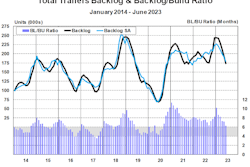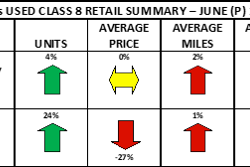
A potential fall recession was the talk of the spring convention circuit. Now with fall just a few months away, that risk hasn’t abated, but it’s also not a given.
During a webinar Tuesday, NTEA’s Steve Latin-Kasper, senior director of market data and research, says entering a recession this year is “about 50/50 at this point.” The economy isn’t booming but it hasn’t cratered either. Inflation has slowed, supply chains and industrial production rates are improving and the service sector continues to expand. Employment levels are steady and hiring rates, while down, are not expected to go negative by most economists, Latin-Kasper says. Political uncertainty exists as a wild card but not one that can be easily forecasted.
The rest of 2023 is unlikely to be a record setter, but it appears a major economic contraction is improbable as well.
“Could we still reach the soft landing the [Federal Reserve] is aiming for — slow growth with no recession — yes, we could,” he says. “We also might have a light or slight recession. It remains to be seen.”
[RELATED: Clouds on the horizon for the trailer market?]
Latin-Kasper says the U.S. Yield Curve has successfully predicted most recessions over the last 40 years and did indicate at the close of 2022 that a recession could occur in late 2023. But he also notes the Federal Reserve has done a pretty good job controlling and slowing inflation over the last year. And the Fed also will meet Wednesday to consider another rate hike.
A slight hike is expected but not guaranteed, though Latin-Kasper says if a hike is announced tomorrow it will likely be the last change of the year.
The economy is operating at a steady level where another rate hike could be enough to keep GDP from consecutive negative quarters. But if a hike is not enacted and a recession was to occur, Latin-Kasper says overwhelming data indicates it will be mild. “Unless something very unusual happens, that recession is likely to be short and shallow.”
Within the trucking sector, Latin-Kasper says NTEA and S&P Global Mobility have improved their chassis forecasts for 2023 in most segments and says this year is now on pace to exceed 2022 in total deliveries. He says an increase in chassis production is the major reason for the improved totals but also states the steady general economy helps.
[RELATED: ACT updates 2024 equipment forecast]
S&P and NTEA recorded 422,323 chassis produced for the Class 2-8 markets last year. Their forecast is now up 7% year over year to a total of 451,996 for 2023. Latin-Kasper says the strongest trending segments are Class 4 and Class 7, as well as conventional and strip chassis. He says the Class 5 space is the only segment trending negative year over year.
NTEA and S&P also have bumped their Canadian forecasts, with total units up 3.6% to 28,575 units. Latin-Kasper says the strongest segment bump there is the low cab over engine (LCOE) space, which fell by nearly 900 units from 2021 to 2022 and is expected to regain 700 units this year.
Beyond this year, Latin-Kasper says NTEA and S&P Global Mobility’s chassis forecasts show mostly positive year over year growth for all segments until 2027. The Class 8 sector could dip into negatives next year but Class 3-7 registrations are anticipated to rise each year until 2027.










